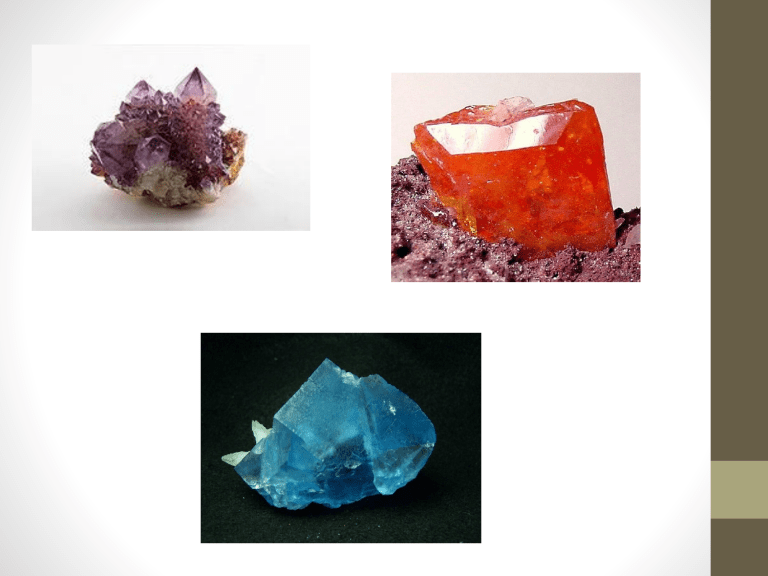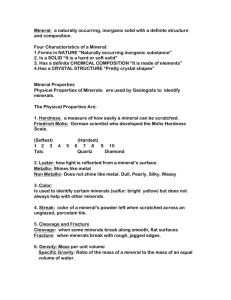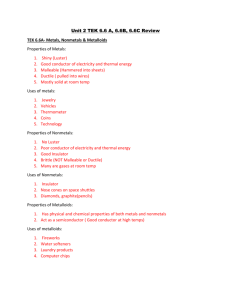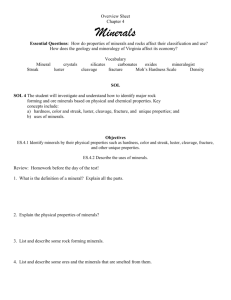Mineral Properties

Minerals
Mineral Facts
• There are about 3000 known minerals on earth.
• All rocks are made up of 2 or more of these minerals.
• Minerals are not rocks!
• Silicon and oxygen are the most abundant elements in the crust and in minerals
• Oxygen is the most abundant element in minerals
Gold
• Turquoise
• Quartz
Sulfur
Magnetite
Azurite
Diamond
How do you identify minerals?
• By properties/characteristics
• Properties stay the same. That’s why we use them.
Mineral Properties:
Color
Inorganic
Natural
Solid
Crystal
Chemistry
Luster
Streak
Not made from living things or fossils
Not man made
Tightly packed, fixed molecules
Repeating patterns
Atomic structure/chemical/internal structure determines the properties of a mineral
Pearly, waxy, earthy, greasy dull
Color of powder
Identifying more Mineral
Properties
• Hardness scratch test
• rub minerals against each other
• or a glass plate,
• finger nail, etc.
• Color-varies
• Streak (streak test -rub against unglazed tile, powder )
• Luster (shine, metallic, glassy, earth, pearly, greasy)
• Density ( amount of matter in a given volume)
• Crystal shape (cubic, right angles, perfect cube)
• Cleavage( splits easily, smoothly along flat surfaces)
• Fracture(does not split evenly)
Diamonds
• Diamonds are the hardest minerals
• Only diamonds can scratch diamonds!!
• A Diamonds internal arrangement of atoms leads to its hardness
Gemstones
• Minerals are cut and polished to make gemstones(jewelry)
• Includes Amethyst, ruby, emerald
• Usually higher up on the MOHS scale(hard)
• Would you want talc in a ring?
Scratch Test Examples
• Hardness Test Example
• 1 Can be scratched easily with fingernail.
• 2 Can be scratched with fingernail, but less easily. talc gypsum
• 3 Can just be scratched with a copper penny. calcite
• 4 Can be scratched easily with a knife but will not scratch glass. fluorite
• 5 Can be scratched with a knife with difficulty.
apatite
• 6 Cannot be scratched with a knife; barely scratches glass. feldspar
• 7 Scratches glass easily.
• 8 Scratches quartz easily.
quartz topaz
• 9 Scratches topaz. corundum
• 10 Scratches topaz and all other minerals.
(ruby, sapphire) diamond
Formation of Minerals
• Crystallization from cooling magma
• Evaporation
How do minerals break?
• 1. Cleavage
• Smooth breakage
Rock hammer and goggle
• To determine cleavage and fracture, you'll need a rock hammer and a safe place to use it on mineral
Cleavage continued.
• Cleavage is the way a mineral breaks. Many minerals break along flat planes, or cleavages—some in only one direction
(like mica), others in two directions (like feldspar), and some in three directions (like calcite) or more (like fluorite). Some minerals, like quartz, have no cleavage. Cleavage is an important property that results from a mineral's molecular structure, and cleavage is present even when the mineral doesn't form good crystals. Cleavage can also be described as perfect, good or poor.
Moh’s Scale of
Hardness
Fracture
• Fracture is breakage that is not flat. The two main kinds of fracture are shell-shaped, as in quartz and uneven. Metallic minerals may have a hackly (jagged) fracture. A mineral may have good cleavage in one or two directions but fracture in another direction
.
Special Properties
• Florescence-glows under ultra violet light.
• Magnetic
• Electrical (quartz when pressure is applied)
Internal Arrangement of atoms
causes the differences in hardness of different minerals has geometric patterns is made ofrepeatingpatterns
Interior of a mineral
• The molecules are used to identify minerals
• Scientist can see them with a special xray machine
• The molecules determine how the mineral will break
A microscopic image shows bacteria covered in electrically conductive grains.
Bacteria can use minerals in soil as electrical grids, which helps the microbes generate chemicals they need to survive, a new study says.
http://news.nationalgeographic.com/news/2012/06/120608-microbes-bacteria-electricity-minerals-chemicals-swap-science
• http://tcm.childrensmuseum.org/geomysteries/cube/b2.html
• Great Website!!
• Mohs Scale of Hardness page








